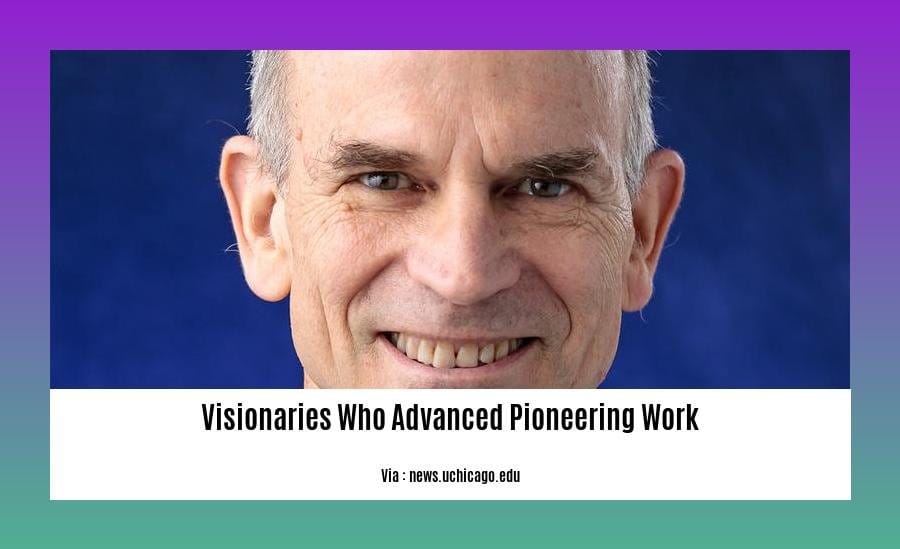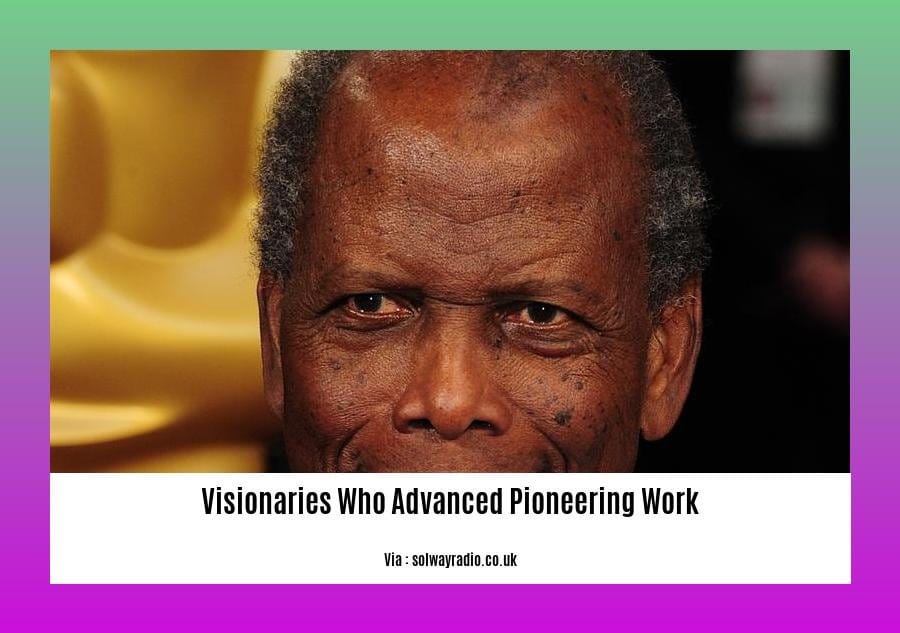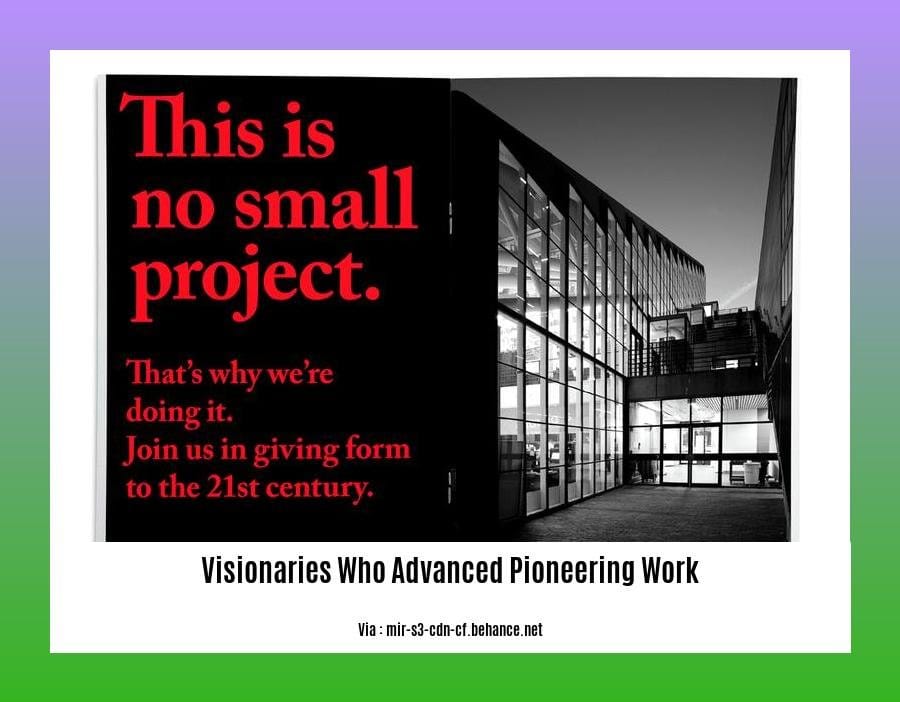In the tapestry of human history, visionary pioneers emerge as threads of brilliance, forever altering the course of progress. Their relentless pursuit of innovation has led to groundbreaking advancements, shaping the very foundations of our world. This article will delve into the captivating stories of those who dared to dream big, whose pioneering work transformed civilizations and continues to inspire generations to come: Visionaries Who Advanced Pioneering Work: Shaping the Course of Human Progress.
Key Takeaways:

- Visionaries challenge accepted norms and drive human progress.
- Galileo Galilei revolutionized science by questioning established beliefs.
- Martin Luther King Jr.’s vision inspired the fight for equality and civil rights.
- Ada Lovelace foresaw the potential of computing technology.
- Curiosity, continuous learning, and a passion for embracing challenges are essential traits of visionaries.
- Visionaries value unique perspectives and inspire others to contribute to collective growth.
Visionaries Who Advanced Pioneering Work
Throughout history, visionary thinkers have fueled innovation and shaped the course of human progress. These individuals possessed the foresight to envision solutions to pressing problems and the determination to turn their dreams into reality.
Steps to Advance Pioneering Work
1. Identify Problems and Opportunities: Visionaries recognize unmet needs or challenges within their fields. They possess an inquisitive nature and constantly seek ways to improve the world around them.
2. Formulate Bold Visions: They develop ambitious visions that challenge existing norms and inspire others to join their cause. Their visions are rooted in a deep understanding of the problem and a belief in the possibility of transformative solutions.
3. Build Teams and Collaborate: Visionaries understand the power of collaboration and surround themselves with talented individuals who share their passion. They foster a culture of innovation and encourage teamwork to achieve their goals.
4. Overcome Challenges and Persist: The path to visionary work is often fraught with obstacles. Visionaries possess resilience and perseverance, staying committed to their goals despite setbacks. They embrace challenges as opportunities for growth and learning.
5. Share and Communicate Your Vision: Visionaries effectively communicate their ideas to motivate and inspire others. They use storytelling, presentations, and other means to convey their vision and gain support for their cause.
Historical Examples
- Galileo Galilei: Challenged the accepted geocentric model of the universe, pioneering modern astronomy.
- Martin Luther King Jr.: Led the civil rights movement in the United States, envisioning a society free from discrimination.
- Ada Lovelace: Envisioned the future of computing and wrote the first computer program.
Actionable Tips
- Cultivate Curiosity: Embrace a thirst for knowledge and continuously seek out new experiences.
- Set Goals and Take Action: Define clear goals and develop a plan to achieve them. Don’t just dream, take action.
- Find Mentors and Support: Seek guidance from experienced visionaries and surround yourself with individuals who believe in your ideas.
- Embrace Failures: View setbacks as learning opportunities and use them to refine your vision and strategies.
- Inspire Others: Share your ideas passionately and motivate others to join your cause.
Innovators progressed by learning from the pioneers whose steps followed previous pioneers. The pioneers who built on prior innovations used these innovations to make further pioneering progress.
Build Teams and Collaborate: A Cornerstone of Visionaries
Crafting a transformative vision is an uphill battle, one that requires collaboration and teamwork at its core. Visionaries understand that their ideas alone are not enough – it’s the collective brilliance of diverse minds that sparks innovation. Collaboration fosters a crucible of ideas, where different perspectives collide, igniting sparks that illuminate unexplored paths.
Key Takeaways:
- Collaboration is the oxygen of innovation: Teams bring together varied perspectives, expertise, and experiences, creating a fertile ground for groundbreaking ideas.
- Trust, respect, and a shared vision are the pillars of collaboration: These elements create a foundation of open communication, empowering team members to share thoughts and challenge ideas without fear.
- Effective collaboration hinges on strong leadership: Leaders set the tone, fostering a culture of respect, open communication, and accountability, encouraging team members to bring their best selves to the table.
- Hybrid teams can achieve greatness with the right strategies: Hybrid work environments require intentional efforts to maintain cohesion and foster collaboration among geographically dispersed team members.
- Visionary leadership drives innovation in multidisciplinary teams: By promoting cohesion and boundary management, visionary leaders create an environment where diverse perspectives can converge, sparking groundbreaking ideas.
Citation:
Team Innovation Through Collaboration: How Visionary Leadership Spurs Success
Overcome Challenges and Persist: The Journey of Visionaries
Despite facing setbacks and skepticism, visionaries persevere, driven by an unwavering belief in their ideas. They navigate obstacles with resilience, adaptability, and an unyielding determination to see their dreams through.
Key Takeaways:
- Visionaries recognize problems as opportunities for innovation.
- They envision bold solutions and inspire others to share their vision.
- Collaboration and teamwork foster creativity and problem-solving.
- Overcoming challenges and persisting is essential for visionary success.
- Visionaries effectively communicate their ideas and motivate others to join their cause.
- Historical visionaries like Marie Curie and Steve Jobs exemplify courage and perseverance.
- Cultivating curiosity, setting goals, and embracing failures are key for aspiring visionaries.
Steps to Overcome Challenges and Persist
- Acknowledge and Evaluate Challenges: Identify obstacles and gather information to understand their nature and potential impact.
- Seek Diverse Perspectives: Engage with others to gain insights, explore alternative solutions, and build support.
- Adapt and Pivot: Remain flexible and open to adjusting strategies while maintaining the core vision.
- Build Resilience: Develop a mindset of perseverance, learning from setbacks, and maintaining a positive outlook.
- Stay Determined: Maintain a strong belief in your vision, even amidst challenges, and never give up.
Case Study: Steve Jobs
Steve Jobs faced countless challenges, including financial difficulties and resistance to his innovative ideas. However, he overcame challenges and persisted, transforming Apple into a global tech giant. By adhering to his vision, collaborating with talented individuals, and staying resilient, he revolutionized the tech industry.
Citations:
- [Visionaries With the Courage to Change the World] (
Share and Communicate Your Vision
Visionaries are individuals who possess the audacity to envision a better future and drive innovation to bring it to fruition. Throughout history, they have played a pivotal role in transforming our world.
Key Steps to Share and Communicate Your Vision
- Identify the Need: Recognize a problem or opportunity, then craft a compelling vision to address it.
- Build a Cohesive Team: Assemble a team of like-minded individuals who share your passion and are committed to your goals.
- Foster Collaboration: Create an environment where diverse perspectives are valued and teamwork thrives.
- Be Bold and Persistent: Don’t fear taking risks or facing obstacles. Embrace challenges as opportunities for growth and learning.
- Communicate Effectively: Articulate your vision clearly and persuasively to inspire and motivate others.
- Share Your Vision: Present your vision in a compelling manner to attract support and gain momentum.
Historical Examples
- Steve Jobs: Revolutionized the tech industry with his vision for intuitive and user-friendly products.
- Marie Curie: Pioneered research in radioactivity, leading to groundbreaking discoveries in medicine and physics.
- Mahatma Gandhi: Led the Indian independence movement with a vision of nonviolent resistance and self-governance.
Actionable Tips
- Cultivate curiosity and a thirst for knowledge.
- Set audacious goals and develop a plan to achieve them.
- Surround yourself with mentors and supporters who believe in your vision.
- Embrace failures as learning experiences and use them to improve your strategies.
- Inspire others by sharing your passion and enthusiasm for your vision.
Key Takeaways:
- Visionaries are change-makers who drive progress.
- Effective communication is crucial for inspiring others.
- Collaboration and teamwork enhance innovation.
- Resilience and persistence are essential for overcoming challenges.
- Sharing your vision empowers others to join your journey.
Most Relevant URL Source:
- The Visionary Leader: A Guide to Shaping the Future

FAQ
Q1: Who are some notable visionaries throughout history?
A1: Galileo Galilei, Martin Luther King Jr., and Ada Lovelace are just a few examples of visionaries who have made groundbreaking contributions to science, society, and technology.
Q2: What are the key traits of visionary individuals?
A2: Visionaries often exhibit curiosity, a passion for continuous learning, a willingness to embrace challenges, a belief in their unique perspectives, and the ability to inspire others.
Q3: How can we harness the power of visionaries to drive progress?
A3: By fostering environments that encourage curiosity, collaboration, and the sharing of ideas, we can empower visionaries to bring their transformative ideas to fruition.
Q4: What role do visionaries play in shaping the future?
A4: Visionaries serve as catalysts for change and advancement. They challenge established norms, imagine new possibilities, and inspire others to work towards a better future.
Q5: How can we support and encourage the visionary spirit?
A5: By valuing diverse perspectives, providing opportunities for education and growth, and recognizing the achievements of visionaries, we can cultivate a society that fosters and nurtures the visionary spirit.
- Unveiling the Enigma: Mansoureh Khojasteh Bagherzadeh’s Public Appearances & Private Life in Iran - July 18, 2025
- Unveiling the Mystery: Mansoureh Khojasteh Bagherzadeh’s Husband: A Rare Glimpse into a Private Life - July 18, 2025
- Unveiling Masoud Khamenei’s Mother: Power, Influence, and Iran’s Future - July 18, 2025
















